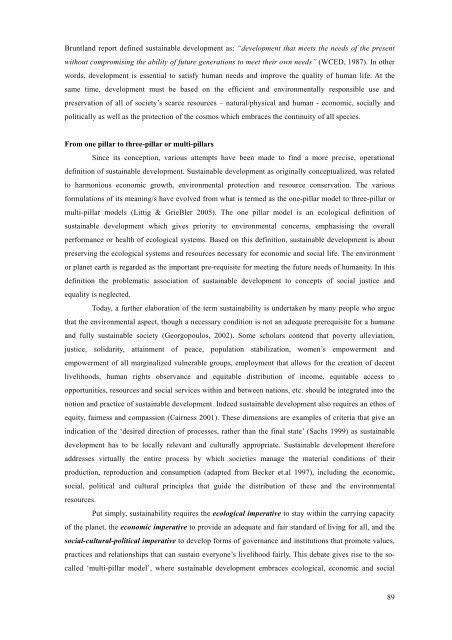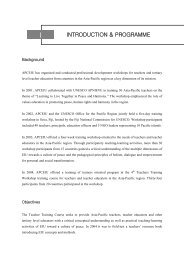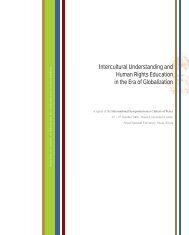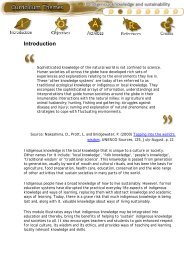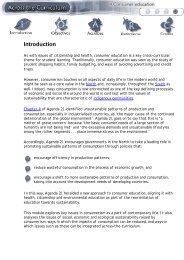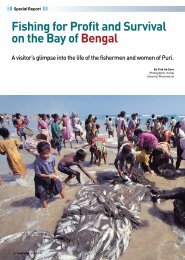REPORT OF UNESCO EXPERT MEETING ON - APCEIU
REPORT OF UNESCO EXPERT MEETING ON - APCEIU
REPORT OF UNESCO EXPERT MEETING ON - APCEIU
You also want an ePaper? Increase the reach of your titles
YUMPU automatically turns print PDFs into web optimized ePapers that Google loves.
Bruntland report defined sustainable development as; “development that meets the needs of the present<br />
without compromising the ability of future generations to meet their own needs” (WCED, 1987). In other<br />
words, development is essential to satisfy human needs and improve the quality of human life. At the<br />
same time, development must be based on the efficient and environmentally responsible use and<br />
preservation of all of society’s scarce resources – natural/physical and human - economic, socially and<br />
politically as well as the protection of the cosmos which embraces the continuity of all species.<br />
From one pillar to three-pillar or multi-pillars<br />
Since its conception, various attempts have been made to find a more precise, operational<br />
definition of sustainable development. Sustainable development as originally conceptualized, was related<br />
to harmonious economic growth, environmental protection and resource conservation. The various<br />
formulations of its meaning/s have evolved from what is termed as the one-pillar model to three-pillar or<br />
multi-pillar models (Littig & GrieBler 2005). The one pillar model is an ecological definition of<br />
sustainable development which gives priority to environmental concerns, emphasising the overall<br />
performance or health of ecological systems. Based on this definition, sustainable development is about<br />
preserving the ecological systems and resources necessary for economic and social life. The environment<br />
or planet earth is regarded as the important pre-requisite for meeting the future needs of humanity. In this<br />
definition the problematic association of sustainable development to concepts of social justice and<br />
equality is neglected.<br />
Today, a further elaboration of the term sustainability is undertaken by many people who argue<br />
that the environmental aspect, though a necessary condition is not an adequate prerequisite for a humane<br />
and fully sustainable society (Georgopoulos, 2002). Some scholars contend that poverty alleviation,<br />
justice, solidarity, attainment of peace, population stabilization, women’s empowerment and<br />
empowerment of all marginalized vulnerable groups, employment that allows for the creation of decent<br />
livelihoods, human rights observance and equitable distribution of income, equitable access to<br />
opportunities, resources and social services within and between nations, etc. should be integrated into the<br />
notion and practice of sustainable development. Indeed sustainable development also requires an ethos of<br />
equity, fairness and compassion (Cairness 2001). These dimensions are examples of criteria that give an<br />
indication of the ‘desired direction of processes, rather than the final state’ (Sachs 1999) as sustainable<br />
development has to be locally relevant and culturally appropriate. Sustainable development therefore<br />
addresses virtually the entire process by which societies manage the material conditions of their<br />
production, reproduction and consumption (adapted from Becker et.al 1997), including the economic,<br />
social, political and cultural principles that guide the distribution of these and the environmental<br />
resources.<br />
Put simply, sustainability requires the ecological imperative to stay within the carrying capacity<br />
of the planet, the economic imperative to provide an adequate and fair standard of living for all, and the<br />
social-cultural-political imperative to develop forms of governance and institutions that promote values,<br />
practices and relationships that can sustain everyone’s livelihood fairly. This debate gives rise to the socalled<br />
‘multi-pillar model’, where sustainable development embraces ecological, economic and social<br />
89


